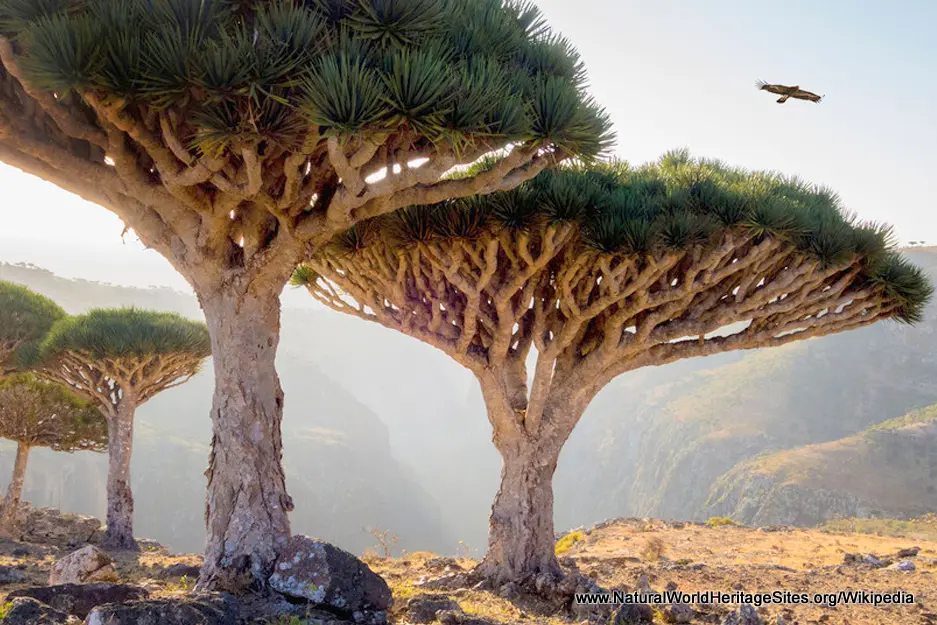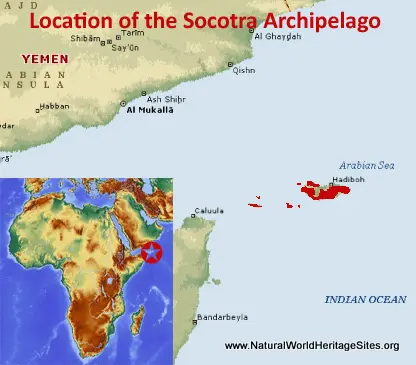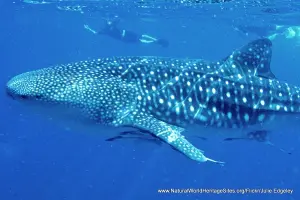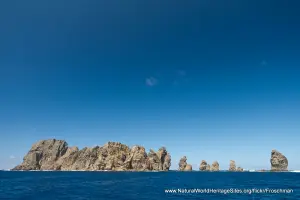EXPLORE Socotra Archipelago with this slideshow, check the location map and get all the facts and information below.
For slideshow description see right or scroll down (mobile). Click to view slideshow
Location and Values: The Socotra Archipelago is located about 250 km from the Horn of Africa, at the junction of the Western Indian Ocean, Arabian Sea and Gulf of Aden. It is a small group of four islands and two rocky islets, set in a diverse marine environment of coral reefs, rocky shorelines and open ocean. It has been termed the ‘Galapagos of the Indian Ocean’ on account of its extraordinary plants and other biodiversity, found nowhere else on Earth. Two thirds of the world heritage area is terrestrial with one third of it covering coastal-marine areas and reefs. It is configured as a serial site with 12 separate terrestrial areas and 25 marine sanctuaries. The main island of Socotra (approximately 135 x 33 km in size) has three rapidly-developing settlements and much of its land is used for domestic stock grazing. Nevertheless 73% of the island’s land and 50% of its coastal/marine areas (stretching 3-4 km offshore) is included within the world heritage site. All the terrestrial areas of the other islands and most of the near-shore marine areas also fall within the site.
Conservation Status and Prospects. According to IUCN’s Conservation Outlook Assessment (2020) the conservation status of the Socotra Archipelago is of ‘significant concern’. Yemen is in a state of political turmoil, and reliable information on the current status of Socotra’s natural resources is this not available. However it is known that the main island is undergoing rapid development and its unique terrestrial biodiversity is thought to be threatened by infrastructure development, habitat destruction, overgrazing, soil erosion, hunting, invasive alien species and climate change. Some of these problems are the result of a breakdown in traditional resource management systems. The present status of the marine parts of the Socotra Archipelago is even less well known, but given the limited capacity of the management authorities, it seems likely that marine resources may be subject to uncontrolled and unsustainable levels of exploitation.
Links:
Google Earth
Official UNESCO Site Details
IUCN Conservation Outlook
UNEP-WCMC Site Description
Birdlife IBA
Slideshow description
The slideshow ‘tells the story’ of the Socotra Archipelago starting with the most iconic of species – the endemic Socotra Dragon’s blood tree, named after its red sap (which is used as a dye and medicine). This is just one of the extraordinary drought-tolerant and succulent plants that live here, where 37% of the 825 plant species are endemic (occurring nowhere else in the world). In the central highlands of the main island these trees grow on rocky granite and limestone plateaux, contributing to the scenic splendor of the distant granite domes that characterize some of the mountain peaks and sheer limestone cliffs. Birdlife International recognizes 22 Important Bird Areas in Socotra, and the slideshow illustrates a small selection of the endemic (and near-endemic) species, including the Socotra sunbird, Socotra white-eye, Socotra golden-winged grosbeak and Socotra sparrow as well as the more widespread Egyptian vulture. Another extraordinary endemic plant that grows on the island’s rocky lower slopes is the fleshy-stemmed Socotra Desert Rose which features in a number of the photos. The final part of the slideshow focuses on the coastal areas with their rocky headlands and gleaming white sand beaches. A couple of photos are included to draw attention to the growing threat of overgrazing by camels and other livestock, and the growth of settlements with all the development pressures that accompany them.
The following Flickr photographers and other sources are acknowledged with thanks for their contributions to this slideshow: Rod Waddington, Valerian Guillot, Nik Borrow, ebird.org, Birdlife.org, africabirdclub.org, amusingplanet.com, Obie Oberholzer, globotreks, adventuresoflilnicki, Dan, Wikipedia, Gerry & Bonni, Salvador Carranza, Maria Victoria Rodriguez, oeil-et-plume.net, Pinterest, cbc.ca, theatlantic.com, Mochail Vorobyev, and worldatlas.com
Factfile
Website Category: Islands
Area: 4,105 km2
Inscribed: 2008
Criteria:
- Natural habitat for biodiversity (x);
- Significant number of rare, endemic and/or endangered species (x)





